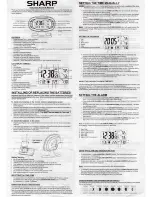
2.
Procedure for manual winding:
•
Push the lower latch and tilt the upper portion of the case backwards to
access the controls and the chronometer.
•
Remove the GPS and RTC Display by lifting it up and backwards (it is
held on curved mounting pins). After it is removed, it may be rested on
the back of the opened upper case. Be careful not to put tension on the
flat, flexible cables which go to the display.
•
Manually rotate the chronometer, carefully, upwards from back to
front, about 180 degrees. This will allow access to the winding
mechanism.
•
Remove the winding key from its nest on the TTC control panel.
•
Place the winding key onto the small square winding stem on the
winding mechanism. (If the AutoWind mechanism has been removed,
the key goes directly into the hole surrounding the chronometer’s
winding stem.)
•
Turn the winding key counter-clockwise to wind the chronometer.
There is a ratcheting mechanism in the key to prevent forcing the
winding stem in the wrong direction. It will take 17 half-turns of the
winding key to fully wind the chronometer if it has completely wound
down. Each day of running will require about half that amount of
winding.
•
Once the “stop” is felt to prevent further winding, remove the key and
return the chronometer to its normal horizontal position. Then, replace
the GPS and RTC Display and close the upper part of the case.
Figure 20: Chronometer Tilted for Manual Winding
•
Summary of Contents for The Time Traveler's Clock
Page 19: ...Figure 12 Cesium Chip Scale Atomic Clock Circuit Board...
Page 23: ...Figure 16 Time Traveler s Clock System Schematic Diagram...
Page 24: ...Figure 17 Hamilton 21 Chronometer Starting Instructions...
Page 25: ...TTC Installation and Operation Manual...
Page 34: ...Figure 21 Gimbal Locking...




































